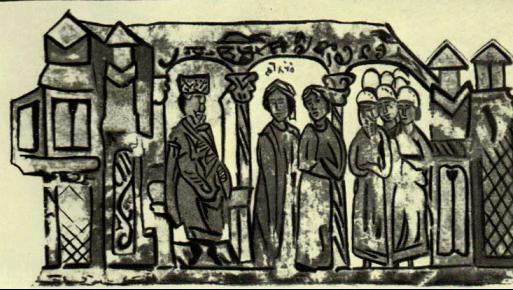The greatest princess in Kievan Rus is considered the wife of Igor Rurikovich - Olga.
Who is Princess Olga?
According to ancient chronicles, the girl was of peasant origin. Due to her positive qualities, as well as her extraordinary wisdom, she was noted by the Grand Duke Igor and was chosen by him as a young teenager. It so happened that for a rather long period the princely couple had no children. This fact contributed to the fact that Olga began to pray to the Christian god, and after a short time the spouses had an heir. Thus, Olga among the pagan people was the first to adopt Christianity and began to help its distribution in Russia. In a sense, the very fact of Olga’s decision to accept the Christian faith testified to her rationality and subtle intelligence. Despite this, Olga's husband and son remained faithful to their pagan gods, who helped them in the battles. Nevertheless, the actions of Olga had an important influence on her grandson - Prince Vladimir, who performed the baptism of Russia. He also chose the Christian religion as the state.
Accession to the throne
Princess Olga became a widow early: during the collection of tribute, Igor was brutally killed by angry Drevlyans. Since the heir was still small, the princess herself ascended the throne.
The first thing she did was to deal with the Drevlyans who executed her husband, sharply suppressing their rebellion. After this, a period began during which the reforms of Princess Olga were implemented. During this time, structural changes occurred in the system of government. The main task of Olga was to prevent future incidents, such as the one that led to the death of her husband.
Innovation and Transformation
What reforms did Princess Olga carry out? First of all, she dealt with the issue of collecting tribute, establishing an orderly tax system. Princess Olga carried out a reform, the aim of which was to weaken tribal power by strengthening her influence. This event is described in "The Tale of Bygone Years" by Nestor: "And Olga went with her son and with the squad in the Drevlyansk land, establishing tributes and taxes." Reforms of Princess Olga began in 946.
Tax reform
An important step was the establishment of the so-called "lessons". Princess Olga recorded clearly defined amounts of tribute, which should have been paid on time. Unlike “polyudy”, this became a more civilized form of taxation, since tribute was collected only once a year in kind: products, furs, as well as various kinds of products.
The meaning of graveyards
The reforms of Princess Olga did not end there. An important innovation was the establishment of pogosts. They were small centers of princely power. From now on, each administrative district acquired its own graveyard and camp, where tribute was collected. Graveyards were also used for trade. Thus, the administrative reforms of Princess Olga contributed to the creation of territorial divisions, which were under the authority of the governor of the prince and were able to repulse any dissatisfied princess policies and decrees. Later, by the 12th century, pogosts turned into control centers of the okrug.

Before Olga’s reign, the collection of tribute was carried out in the form of a polyud - an annual winter detour of possessions by representatives of the authorities, during which tax could be collected twice from one yard. Of course, this fact caused discontent and indignation of the payers. However, with the introduction of pogosts, people who brought tribute received a special princely seal, which saved them from collecting tax again. This reform Olga carefully put into effect, gradually honing its mechanism. In the process of implementing the new system, most local princes lost their power, and the independence of autonomous tribes was sharply curtailed. The work carried out by Olga did not receive publicity and rave reviews, but it was of great importance in the development of statehood.
Approval of Tyuns
The next step was the appointment of tiun-collectors of tribute to the graveyards. Before entering the Old Russian state, the Eastern Slavs called tyuns “cattle”. First of all, this reform testified to the development of commodity-money relations. Instead of cattle, the Russians approved a special form of equivalent, reminiscent of metal money.
If we list the reforms of Princess Olga briefly, we can highlight certain aspects. This is the statement of lessons, the creation of graveyards and the appointment of collectors of Dani-Tiuns. Princess Olga during her reign carried out the first financial reform in Russia. She established a fixed tribute amount and the order of her fees. The meaning of the activities of Princess Olga was to normalize duties, centralize Kiev power, weaken the local (tribal) power.
In other words, Princess Olga's reforms contributed to replacing the tribute collected from autonomous tribes with the same fixed tax paid by the entire population. At the same time, the probability of re-collection from one payer was avoided.
Thus, the reforms of Princess Olga finally approved the central authority of Kiev, streamlined the taxation system, and created the administrative division of the state. Later , Olga's domestic policy was sung by the people in legends and songs. Thanks to the introduction of the Christian religion, Olga was elevated to the rank of saints and became an equally apostolic preacher. Changes in the social, political and economic, spiritual sphere made it possible to strengthen Russia. Of course, this was the most important stage in the history of the creation of Russian statehood.